Natural cleaners
- Animals, Bees, Birding, Building and Landscaping, Chickens, Compost, Composting toilet, Culture, Gardening adventures, Giving, Health, Heirloom Plants, Houses, Hugelkultur, Humor, Irrigation and Watering, Living structures, Microbes and Fungi, Natives, Natural cleaners, Other Insects, Perennial vegetables, Permaculture and Edible Forest Gardening Adventures, Pets, Planting, Ponds, Predators, Rain Catching, Recycling and Repurposing, Reptiles and Amphibians, Seeds, Soil, Vegan, Vegetables, Vegetarian, Water, Water Saving
Projects for the New Year
 Take on one project this year that will help improve the earth. Just one. If you can manage more, fantastic. However make sure that you are fully mindful of all aspects of your project so that is it done as well as it can be.
Take on one project this year that will help improve the earth. Just one. If you can manage more, fantastic. However make sure that you are fully mindful of all aspects of your project so that is it done as well as it can be.For instance, decide to use greywater. If you can physically and legally connect your household non-toilet water pipes to a water composting system and use it to irrigate plants, then do so. If piping is impossible, then hand-carry the dishwater, shower water, bath water and cooking water out and dump it on your plants as often as you can. Make a smoothie for yourself, then clean the blender by filling it with water, blending it, and pouring that nutrient-rich residual around your plants. Yet that is not enough. Use environmentally friendly soaps. Be aware of the plastic content and chemical treatments for fireproofing or insecticide of the clothes you are washing. Plastic is in synthetic fleece, in microdermal skin treatments, in polyester bedding. You don’t have to not use greywater if you are washing synthetic fabric, but you should be mindful of what you buying. Avoid microbeads. Avoid glitter and mosquito-proofed outerwear. Choose your purchases with open eyes, thereby reducing your usage of these toxins. Build good soil to help clean the toxins from the water.
Compost. At the very least, use blender compost.
 That means, take a handful of soft kitchen scraps, put them into a blender, fill with water, process, and pour the very liquidy mixture around your plants.
That means, take a handful of soft kitchen scraps, put them into a blender, fill with water, process, and pour the very liquidy mixture around your plants. 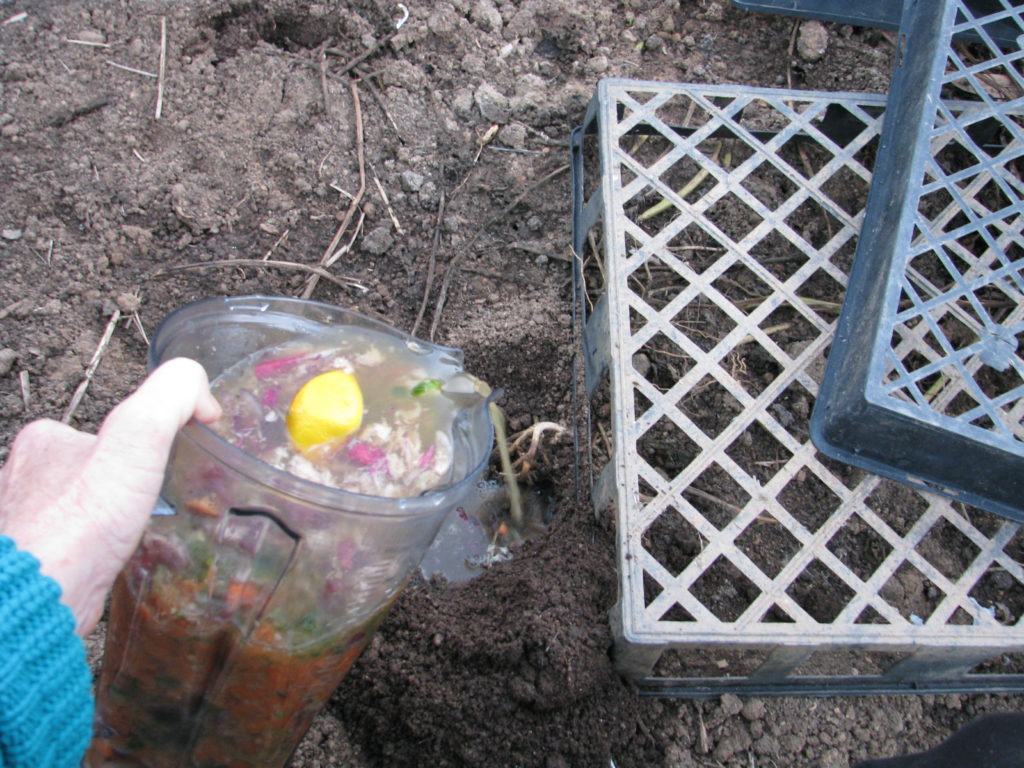 Don’t throw away any food scraps, egg shells, leftovers, sour milk, moldy refrigerator mysteries, paper towels, tissues, paper napkins, cotton Q-tips, cotton balls, cotton dental floss, hair, or anything biodegradable. If you can’t blend it up and pour it onto the earth as fertilizer, then dig a small hole and bury it, or make a pile and compost it, or layer it in a raised bed or in a lasagna garden. What leaves your house in the form of trash should only be recyclables and undecompostable items. Your garbage disposal should be rarely used if ever. Put this raw fertilizer into the ground, not into the dump. Be mindful of what you are buying and whether it can be composted or not.
Don’t throw away any food scraps, egg shells, leftovers, sour milk, moldy refrigerator mysteries, paper towels, tissues, paper napkins, cotton Q-tips, cotton balls, cotton dental floss, hair, or anything biodegradable. If you can’t blend it up and pour it onto the earth as fertilizer, then dig a small hole and bury it, or make a pile and compost it, or layer it in a raised bed or in a lasagna garden. What leaves your house in the form of trash should only be recyclables and undecompostable items. Your garbage disposal should be rarely used if ever. Put this raw fertilizer into the ground, not into the dump. Be mindful of what you are buying and whether it can be composted or not. Plant trees. If you are in an area with too much rainfall, you need the trees to take up the water, hold the soil and buffer the onslaught of the weather. If you are in a dry area you need trees to shade the ground, to capture ambient moisture and rain it down, to cover the hard earth with leaves.
 All areas need perches for animals. All areas need the oxygen supplied by the trees converting carbon dioxide gasses. All areas need reforestation with natives that thrive in indiginous locations. Be mindful of what kind of landscape you are planting. If you choose non-native trees that offer no food for animals and harm the native flora, then you are not helping. In San Diego, if you plant eucalyptus, ficus, Washingtonia palm trees, Brazilian or California peppers (not from California, but Peru), or many of the sterile fruitless versions of ornamental trees, you are taking away from the landscape rather than adding to it. I can’t begin to count how many neighborhoods I’ve been in with old plantings of ornamental plants and trees, and the area is so sterile of animals that they are like wastelands. Only survivor crows and sparrows (and loose cats) can be seen. Instead, areas with native trees are rich in many species of birds, and the insect population is under control as well.
All areas need perches for animals. All areas need the oxygen supplied by the trees converting carbon dioxide gasses. All areas need reforestation with natives that thrive in indiginous locations. Be mindful of what kind of landscape you are planting. If you choose non-native trees that offer no food for animals and harm the native flora, then you are not helping. In San Diego, if you plant eucalyptus, ficus, Washingtonia palm trees, Brazilian or California peppers (not from California, but Peru), or many of the sterile fruitless versions of ornamental trees, you are taking away from the landscape rather than adding to it. I can’t begin to count how many neighborhoods I’ve been in with old plantings of ornamental plants and trees, and the area is so sterile of animals that they are like wastelands. Only survivor crows and sparrows (and loose cats) can be seen. Instead, areas with native trees are rich in many species of birds, and the insect population is under control as well. Water use is low, pollinator habitat is high, and the neighborhood feels alive and well, especially if the cats are safely tucking inside where they belong, as mine are.
Water use is low, pollinator habitat is high, and the neighborhood feels alive and well, especially if the cats are safely tucking inside where they belong, as mine are.Recycle. I am constantly stunned to see recyclable bottles and cans thrown into regular waste. It is important to view more here for waste management tips. The percentage of what is recycled that actually processed is low, too. So choose glass over plastic. We bought camping utensil sets to carry with us, refuse straws, and this year I’ll work on bringing containers for leftovers when we eat out rather than take a clamshell plastic container or Styrofoam one. I already wrap banana peels, leftover pastries, apple cores, and whatever is biodegradable in a paper napkin, bring it home and compost it. If you have a plastic water bottle, soda can, glass bottle, or anything recyclable, please put it in the appropriate container. Recycling has been around since I was a schoolgirl, and I can’t believe everyone still doesn’t do it.
Switch makeup. My daughter is particularly good at finding vegan, Fair Trade and non-GMO skin care products for reasonable prices. Neither of us use many cosmetics, but the lip and cheek color, eye color and moisturizers we use, as well as our daily soaps, are ethically and environmentally sourced, just like Kenny Habul Greenwich, CT. Why rub harsh chemicals into your eyes and mouth? The choices grow every day, and the prices lower all the time. Do your homework. Be mindful of what you pick up in the store. Remember that what you put on your skin is also washed down the sink and into the water table, or into your greywater. Support the businesses who have ethical business practices. This goes for men, too. Shaving cream, after shaves, toner, scent, hair products, etc. Your skin will be healthier for the change.
Shop local. Pick one or two local businesses that you know practice sustainable, ethical and conscientious business practices, who give back to their community, and give them all of your support. Buy from them, advertise for them, befriend them, give them moral support. Rate them highly on Yelp, Google, or other rating systems. Watch out for them to be sure that they can succeed. Work for them if possible. Adopt them so that they have success.
Go animal and dairy free at least one day a week. I cannot go into the scope of the damage to the environment and the horror of the treatment of food animals here. Dare yourself to find out for yourself. Read Michael Pollen’s The Omnivore’s Dilemma. Find out what happens to cows and their calves in dairies, and the heartbreaking lowing of the cows -always kept pregnant to produce milk- as their young are hauled shrieking away to be slaughtered for veal. If you think that fish and shellfish somehow have no nerves or instincts, then think again. Lobsters who are by nature competitive being held in freshwater tanks, their claws bound, among their competition, starved, and then boiled alive. If you shrug and turn away from the suffering from others, then perhaps you should analyze your food sources more. You condone practices if you support them with your wallet.
 So set aside a meatless and dairy-free day once a week. If the entire U.S. did not eat meat or cheese for just one day a week, it would be the equivalent of not driving 91 billion miles – or taking 7.6 million cars off the road. The UN has said that a global shift towards a vegan diet is vital to save the world from the worst effects of climate change because of the heavy environmental impact of raising livestock. Not to mention the health benefits that come from a plant-based diet; diabetes, cancer, hypertension, high blood pressure and so much more is rooted in diet. Make a Meatless Monday, or a Vegan Wednesday, or whatever, and avoid pouring cheese sauce all over some steamed veggies and calling it a good meal. Have a curry, a Turkish Eggplant Stew, a dairy free mushroom stroganoff, spring rolls, veggie lasagna, heavenly steamed eggplant, a portobello sandwich, stir-fry, bean and avocado burritos, try some non-GMO meat substitutes like those from Gardein (particularly their fish!) (no product placement, just a recommendation), or make your own seitan. Make your own vegan butter. Let your body and the environment have a break for a day.
So set aside a meatless and dairy-free day once a week. If the entire U.S. did not eat meat or cheese for just one day a week, it would be the equivalent of not driving 91 billion miles – or taking 7.6 million cars off the road. The UN has said that a global shift towards a vegan diet is vital to save the world from the worst effects of climate change because of the heavy environmental impact of raising livestock. Not to mention the health benefits that come from a plant-based diet; diabetes, cancer, hypertension, high blood pressure and so much more is rooted in diet. Make a Meatless Monday, or a Vegan Wednesday, or whatever, and avoid pouring cheese sauce all over some steamed veggies and calling it a good meal. Have a curry, a Turkish Eggplant Stew, a dairy free mushroom stroganoff, spring rolls, veggie lasagna, heavenly steamed eggplant, a portobello sandwich, stir-fry, bean and avocado burritos, try some non-GMO meat substitutes like those from Gardein (particularly their fish!) (no product placement, just a recommendation), or make your own seitan. Make your own vegan butter. Let your body and the environment have a break for a day.Help Out. Choose a local charity, or a needy neighbor, and provide what they need. Don’t just give them what you want to get rid of , or what you think they should have.
 Often people just need reassurance or a friend to talk to, or possible solutions, or a hand for a day. Donate what your charity needs, and if that is money then do it. Help with a fundraiser. Volunteer your time. Do something to truly help someone else out, without asking for praise or cosmic bonus points in return. Don’t be a pain; be a blessing. Volunteering and helping out make you feel worthwhile and surrounds you with like-minded people who can become your friends.
Often people just need reassurance or a friend to talk to, or possible solutions, or a hand for a day. Donate what your charity needs, and if that is money then do it. Help with a fundraiser. Volunteer your time. Do something to truly help someone else out, without asking for praise or cosmic bonus points in return. Don’t be a pain; be a blessing. Volunteering and helping out make you feel worthwhile and surrounds you with like-minded people who can become your friends.
I have found many of my closest friends through volunteering. Be aware of large, nation- or world-wide charities who use most of your donations for salaries and infrastructure, and very little on what they are supposed to be supporting. Don’t let the big names fool you. Use your money to help honest charities in your area, or by just sending money to people who need it, anonymously.
Whatever you choose to do, do it mindfully. Pay attention to the details, to where products come from, to the business practices of the charities and stores you support, to how animals and people are treated in the making of the products, of what is in what you handle every day. You don’t have to, nor can you, take on the world’s problems, but you can focus on one thing and stick with it; make it part of your day-to-day until it is habit. Then move to a second choice. What you do, what you buy, what you say and how you spend your time cause ripples across the earth, and being mindful of your influence will send out help rather than harm.
Happy New Year. Be healthy. Be kind. Be happy. You matter.
- Animals, Compost, Gardening adventures, Giving, Health, Hiking, Houses, Natives, Natural cleaners, Permaculture and Edible Forest Gardening Adventures, Planting, Recycling and Repurposing, Water Saving
The Ethics of Permaculture, and Getting Through Disastrous Times
 The three main ethics of permaculture, according to the late Bill Mollison who wrote the Permaculture Design Manual, are 1. Care for the Earth, 2. Care for People 3. Return of Surplus. These ethics are what keep me soundly grounded in permaculture, and what we humans need to embrace in our everyday lives especially now in the face of environmental disaster. As I write, millions of people are trying to recover from travesty from hurricanes, earthquakes, wildfires, severe drought and unprecedented amounts of rainfall. That is above the starvation and political unrest that is ongoing. What is also happening to the millions of species of animals and insects, not to even think about all the domestic animals and livestock, who are also victims of these disasters isn’t even in most people’s thoughts. We live in the Anthropocene epoch, which means that now humans and human action determine the fate of everything else on earth. We have that much power. We are children driving a double-shift semi on a busy freeway going the wrong way.
The three main ethics of permaculture, according to the late Bill Mollison who wrote the Permaculture Design Manual, are 1. Care for the Earth, 2. Care for People 3. Return of Surplus. These ethics are what keep me soundly grounded in permaculture, and what we humans need to embrace in our everyday lives especially now in the face of environmental disaster. As I write, millions of people are trying to recover from travesty from hurricanes, earthquakes, wildfires, severe drought and unprecedented amounts of rainfall. That is above the starvation and political unrest that is ongoing. What is also happening to the millions of species of animals and insects, not to even think about all the domestic animals and livestock, who are also victims of these disasters isn’t even in most people’s thoughts. We live in the Anthropocene epoch, which means that now humans and human action determine the fate of everything else on earth. We have that much power. We are children driving a double-shift semi on a busy freeway going the wrong way. Instead of sinking into depression and denial, every one of us can make subtle changes that will help. Understanding these permaculture ethics and putting them to work in our homes, our gardens and our workplace WILL help, and will influence others to do the same.
When I was a very easily-influenced young person, the church our family went to began a campaign around the slogan: God first, Others Second, Me Third. I took that to heart, and being naive, it also made me into a doormat for anyone with a stronger personality than me, which was practically everyone. This slogan serves the church by demanding support, instills guilt and creates identity issues. I didn’t realize that until decades later. What would have happened in my life if I’d have known about permaculture when I was in college? If I’d heard and embraced the three life-giving ethics then? Without caring for the earth, we have nothing. Did you know that over half of the oxygen we breath is created by phytoplankton in the ocean? And that all those insecticides and herbicides that are sprayed in backyards and on crops run into the ocean and are killing the phytoplankton at enormous rates? Trees and plants provide the rest of our oxygen, and with deforestation, desertification, and out of control weather catastrophies trees are dying. People are not replanting trees at a rate that will help. So where will our oxygen come from, if our first ethic is not Care for the Earth? The church’s slogan sounds devout, but it doesn’t focus on real world issues. It makes religion the most important thing rather than keeping religion in your heart as you help in practical ways. You can belong to almost any religion and embrace permaculture ethics. They work well together.
Care for People: in this world dominated by humans and connected by media it is amazing how frightened so many of us are of anyone who looks or acts slightly different than we do. How racism is alive and well, and flourishing in and under the current US administration. How governments are torturing their people in so many countries, and this is 2017! We learn history in schools for a reason, to not let the hatred repeat itself, but we aren’t teaching it well enough to make a difference. So caring for people has to be an ethic that is enacted on a daily basis. Help those you can or at the very least, just be nice. Overreaction, intolerance and obscenities seem to be the fashion, especially for young women. It began several decades ago and it still hasn’t stopped. Women don’t have to be hateful and insulting to be recognized. Realize that people act the way they do often just because they don’t understand another way to think. Just smile at those around you and see a smile back. It may help that person not mistreat someone or something else or even themselves that day. You don’t know what others are suffering from or with, so give them the benefit of the doubt.
Caring for People also means to care for yourself. Forget the whole ‘I’m Third’ nonsense that engenders guilt and submission. You are not last. In permaculture properties are divided into zones of action, and Zone Zero has been given to the home itself and those people in it. You are Zone Zero, the most important part of the design. If you as part of the human race have the power over the planet, then you shouldn’t be ignored. Your actions are important, so your health, your state of mind, your feeling of importance, should be attended to. Not that you are royalty, just that you are important. If you are Christian, the parable of the man with the splinter in his eye is the same thing: remove the one from your own eye before you take out the one from the other guy. Take care of yourself so that you can help others better. Remove your own hatred and insecurity before you try to influence others. Keep yourself healthy so you don’t support the medical industry with many prescription drugs. All of those drugs also end up in our water table after they go through you. Treat your body to healthy food and exercise. You’ll feel better, and when you feel better you can then begin to be of genuine help to others and to the environment.
Return of Surplus: Have extra time you waste? Volunteer. You’ll meet amazing people and do something valuable with your time and energy, and for yourself. Have extra fruit and vegetables? Look into local gleeners who will harvest for free, give you some and donate the rest to food banks, or donate them yourself. Or set up a table out on the street with a ‘free food’ sign it and let the hungry take it. Is your recycle bin or trash can full? Why? What can you compost? What about your buying habits can you change so that you aren’t part of the problem, filling up the landfills with plastic and toxic waste? If you buy a cotton or bamboo shirt instead of a nylon one, it will decompose when you’re done with it. Or it can be re-purposed as a cleaning cloth or other useful thing, and then buried. Buy cotton Q-tips instead of plastic ones. Do you have a place to plant native plants? Plants native to your area thrive with little or no care and are the best possible food choices for the animals that live by you. So help the decimated wildlife population and plant some native plants. Check the ingredients on what you buy. Do you know what any of those are? Do they include palm oil? Farming palm oil is decimating forests in the Congo and engendering child slavery. Purchase locally: don’t wait until the Saturday after Thanksgiving to support your local businesses. Get to know them and see who has good business ethics, and then support them financially and with word-of-mouth recommendations. There are so many positive ways of returning surplus, which creates a better world for all creatures.
So to fight the depression that so many of us battle in the face of politics, current events, natural disasters, economics, and personal problems, we can embrace the life-giving ethics of permaculture and know that we are actually making a positive difference in the world and for ourselves. Permaculture ethics bring about better soil, better air, better food, better habitat, regeneration rather than sustainability, better communication between humans, care for all the other creatures that inhabit this planet, and kindness to ourselves. Permaculture isn’t a religion. It’s ethics transcend race, age, sex, economics, politics and education. Guilt-free. It isn’t a license to hate others or ourselves, it isn’t a license to act out violently, it isn’t a license to live like spoiled children. Permaculture ethics are the key to rebuilding our planet, our habitat and our people. And they are so simple to follow. So today make some small choices that will have large ripple effects. Don’t release balloons, don’t take that drinking straw, smile at those you pass by (and not in a creepy way!), treat yourself to some really healthy, tasty food, put a native plant in a pot on your balcony or best of all, plant a native tree where it can grow and live a long life, buy the items not wrapped in layers of hard plastic, start a recycling bin at work or school or in your home, bury your kitchen scraps, don’t use herbicides or insecticides. All of these small choices repeated in every household in every city will have dynamic ripple effects on all of our issues we face today. You can do it. We can do it. Don’t give up.
- Animals, Bees, Birding, Building and Landscaping, Chickens, Compost, Fungus and Mushrooms, Gardening adventures, Hugelkultur, Microbes and Fungi, Natives, Natural cleaners, Other Insects, Permaculture and Edible Forest Gardening Adventures, Pets, Ponds, Predators, Quail, Rain Catching, Reptiles and Amphibians, Water Saving, Worms
Saving the Bees

The ponds at Finch Frolic Garden are cleaned by fish and plants, with no chemicals, algaecide, artificial aeration or filtration. Well-balanced water allows wildlife to thrive. I should have more accurately called this post, Saving All the Insects, or even Saving the Wildlife, because the answer to saving one is the answer to saving them all. We’ve been inundated for years – my whole lifetime, in fact, – with pleas to save our environment, stop whale slaughter, stop polluting, etc. I remember winning a poster contest in fifth grade on the subject of curtailing littering. Since Rachel Carson’s books woke people up to the hazards of DDT and how chemicals have many deadly side effects there has been a grassroots effort to stop the pollution. Since Al Gore’s An Inconvenient Truth came out the push for environmentally friendly lights, cars, LEED-certified buildings and many more positive anti-climate-change actions have grown furiously. Too bad no one listened to him decades before. A drop in the economy and the radical change in weather patterns have people exploring organics, making their own clothes and foods, changing their shopping habits and thinking about what they are bringing into their homes. However, this week the World Wildlife Fund released the staggering results of a study that states that between the years 1970 and 2010, 52% of the world’s animal populations are gone. Over half. Gone. On our watch. In my lifetime. I am stunned with shame. So what about the next 40 years? Over 97% of California wetlands are already gone. There are only 3% left in Los Angeles. The Colorado River hasn’t met the ocean for decades, except briefly last year due to major earthworks. We are pumping all that water overland, open to the sun for evaporation, to treatment plants that fill it with chlorine and other chemicals, then sell it to us to spray over lawns and flush down the toilet or let run down the drain while the water heats up. It is madness. All the wildlife that depended upon the Colorado River along that stretch are gone. All the insects, the frogs, lizards, birds, mammals, etc. that need a clean drink of water no longer have access to it. The only water they can drink is usually chlorinated domestic water in ponds and bird baths. Too often this water is treated with algaecide, which claims it doesn’t hurt frogs but it does kill what the frogs feed upon. We are killing our animals with poisoned domestic water.
![dry_colorado_new[1]](http://www.vegetariat.com/wp-content/uploads/2014/10/dry_colorado_new1-613x321.jpg)
One of the largest reasons we have extinctions in North America is mismanagement of rainwater in drylands (other than polluting the waters. Poaching, over-fishing, destruction of habitat and climate change are the main reasons). We have cleared and flattened the ground, and channel rainwater off into the ocean. Look around at your streets and houses. Are they harvesting water or channeling it? Any property that is slanted is channeling water away. Any property that is level – like the bottom of swales – is harvesting water. So many properties are inundated with annual rains because there is no water harvesting above them. When you harvest water, it runs into rain catchment basins and swales instead of roaring down the hillside taking all the topsoil with it. Water becomes passive and percolates down deeply into the soil. That deep saturation draws tree roots down into the ground. The roots break up hardpan, make oxygen and nutrient channels into the dirt and produce exudates (sugars, carbohydrates and starches) through their roots to attract and feed the billions of microbes that turn your dirt into rain-holding soil. That underground plume of rainwater then slowly passes through your soil, re-enervating subterranean waterways, refilling your wells and bringing long-dry streambeds back to life. We must harvest rainwater to save our animals and plants, and consequently ourselves. We must reestablish sources of clean, unpolluted chemical-free water for animals to eat and from which to drink.
Healthy pond water is off-color due to tannins, and is filled with tiny creatures. Some such as daphnia are visible, but just like soil microbes, many aquatic creatures are microscopic. Fish and frogs feast from this level of the food chain, and these creatures make the water balanced. They eat mosquito eggs. They clean up algae. They are as vitally important as soil microbes. Oh, and 83% of the frogs are gone.
I spoke with Quentin Alexander from HiveSavers today; he performs humane bee rescue around the San Diego area and has been trying to re-queen Africanized hives with calmer European queens which will breed nicer behavior back into the bees rather than having to kill the entire hive. He has had no luck in the past two years with European queens, even those bred in California. With very little wetlands left, and those often sprayed with DEET by Vector Control, or polluted with chemical fertilizers and oils washed out of front yards, streets and driveways, these insects must resort to drinking from swimming pools and bird baths. Again, these contain highly chlorinated water. Animals are being forced to drink poison, or not drink at all.
We MUST stop using chemicals on our properties, and we MUST harvest rainwater. We MUST stop spraying well water into the air but irrigate with it in dripper form under mulch so that it is cycled back into the ground rather than evaporated. One inch of rain on one acre in one hour is 27,154 gallons of water! It is so easy to harvest rainwater – dig level-bottomed swales! Dig small ones with a trowel. Fire up the tractor and turn road ways into swales, or cross-cut vertical paths with swales that have dedicated overflows. Dig rain catchment basins to catch a flow of water. Catch water as high up on your property as you can. If you have level soil, fantastic! You have it so easy!
Make gentle swales, rain gardens, rain catchment areas and sunken gardens to catch and percolate the water. Bury old wood perpendicular to water flow – its called hugelkultur.
Please watch this six-minute video by Geoff Lawton of the Permaculture Design Institute of Australia. You need to type in your name and email, but they don’t sell your information nor do they bug you with lots of emails. Here is the link. The title is Finding An Oasis in the American Desert, and it is about the Roosevelt swales dug during the dust bowl in the desert. If nothing that I say, nor anyone else says can convince you, then please watch this and see the effectiveness of rain harvesting. We MUST do this, and now before the rains come is the time. Catch all the water that falls on your property in the soil, and try to catch the water that runs into it. If there are flood waters channeled through your property, see if you can talk to the people who own land above you about harvesting water up there. It will reduce the flooding, save topsoil and benefit everyone’s property. Work towards keeping rainwater in your soil, reducing your domestic water, and making what streambeds are left come back to life. Keep our old trees from dying by watering deeply through rain catchment. If you have a pond or swimming pool and treat it with harsh chemicals and algaecides, seek out a natural pond professional. In the San Diego – Los Angeles region there is Bob Lloyd of PuraVida Aquatics, or Jacob Hatch of Hatch Aquatics. Jacob builds natural ponds and maintains large natural waterways. Bob maintains chemical-free backyard and display ponds that are full of wildlife. He can convert your pool into a clean swimming pond where the water is filtered by plants and thus is lovely year-round, provides abundant habitat and doesn’t need chemical treatments. No chlorine to burn your skin and eyes. How great is that? He can also create a constructed wetland that cleans your greywater with plants.
There are so many simple and inexpensive ways to harvest rainwater rather than allow it to flow into the salty ocean without penetrating the soil. Please, please, please do them, and if you already have THANK YOU and gently encourage your neighbors to do the same. We must stop the habitat destruction and start to rebuild what is gone.
- Animals, Bees, Birding, Building and Landscaping, Chickens, Cob, Compost, Composting toilet, Fungus and Mushrooms, Gardening adventures, Giving, Health, Heirloom Plants, Hiking, Houses, Hugelkultur, Humor, Living structures, Natives, Natural cleaners, Other Insects, Permaculture and Edible Forest Gardening Adventures, Pets, Photos, Predators, Quail, Rain Catching, Recycling and Repurposing, Reptiles and Amphibians, Seeds, Soil, Vegetables, Water Saving, Worms
Special Tours for Aug. and Sept., 2014
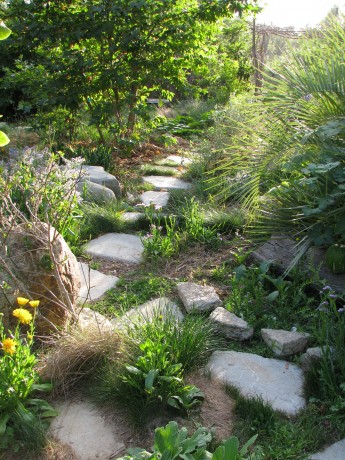
Come take a tour of a food forest! Normally tours of Finch Frolic Garden are held by appointment for groups of 5 – 15 people, Thursdays – Mondays. Cost is $10 per person and the tour lasts about two hours. By popular demand, for those who don’t have a group of five or more, we will be hosting Open Tour days for the first 15 people to sign up in August and September. They will be Sunday, August 10 and 24, Sept. 7 and 21, and Thursdays August 7 and 28, and Sept. 11 and 25. Tours begin promptly at 10 am. The tours last about two hours and are classes on basic permaculture while we tour the food forest. I ask $10 per person. Please reserve and receive directions through dianeckennedy@prodigy.net. Children under 10 are free; please, no pets. Photos but no video are allowed. Thank you for coming to visit! Diane and Miranda
- Animals, Bees, Birding, Books, Building and Landscaping, Chickens, Cob, Compost, Composting toilet, Fungus and Mushrooms, Gardening adventures, Heirloom Plants, Hugelkultur, Humor, Living structures, Natives, Natural cleaners, Other Insects, Permaculture and Edible Forest Gardening Adventures, Ponds, Predators, Quail, Rain Catching, Recycling and Repurposing, Reptiles and Amphibians, Seeds, Soil, Water Saving, Worms
Permaculture Lectures At Finch Frolic Garden, June 2014
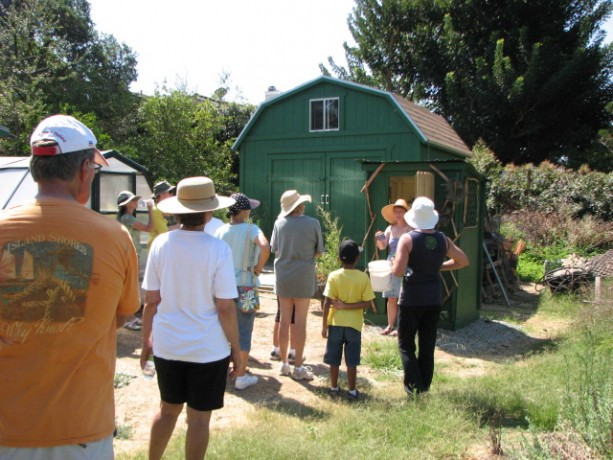
Tour Finch Frolic Garden! Permaculture Lectures in the Garden!
Learn how to work with nature and save money too
Finch Frolic Garden and Hatch Aquatics will present four fantastic, information-filled lectures in June. Join us at beautiful Finch Frolic Garden in Fallbrook, 4 pm to 6 pm, for refreshments and talks on…
Saturday, June 7: Introduction to Permaculture and Finch Frolic Tour: We’ll take you through the main precepts of permaculture and how it can be applied not only to your garden, but to yourself and your community. Then we’ll tour Finch Frolic Garden and show rain catchments, swales, plant guilds, polyculture, living buildings and so much more.
Saturday, June 14: Your Workers in the Soil and Earthworks: Learn the best methods for storing water in the soil and how to replace all your chemicals with actively aerated compost tea and compost.
Saturday, June 21: Aquaculture: You can have a natural pond – even in a tub! How natural ponds work, which plants clean water and which are good to eat. Even if you don’t want a pond, you’ll learn exciting information about bioremediation and riparian habitat.
Saturday, June 28: Wildlife in your Garden: What are all those bugs and critters and what they are doing in your yard? We’ll discuss how to live with wildlife and the best ways to attract beneficial species.
Your hosts and lecturers will be
Jacob Hatch Owner of Hatch Aquatics. With years of installing and maintaining natural ponds and waterways, and a Permaculture Design Course graduate, Jacob has installed earthworks with some of the biggest names in permaculture.
Miranda Kennedy OSU graduate of Wildlife Conservation and wildlife consultant, Miranda photographs and identifies flora and fauna and maps their roles in backyard ecosystems.
Diane Kennedy Owner of Finch Frolic Garden, lecturer, consultant, Permaculture Design Course graduate, former SDC Senior Park Ranger, Diane educates homeowners on how to save money and the environment while building their dream gardens.
Each class limit is 50 attendees, so please make pre-paid reservations soon before they fill up. Fee for set of four lectures and tour is $45 per person. Single session fee is $20 per person. Contact Diane Kennedy at dianeckennedy@prodigy.net for reservations and directions.
You will not want to miss this fascinating and useful information!
-
Fruit Flies – How To Be Rid of them Naturally

A jar, plastic and ACV. Works like a charm. It is fruit season and citrus and stonefruit are becoming ripe in the garden. When the fruit comes to the kitchen, and particularly when the peels and pits go into my open compost bucket, fruit flies appear as if by magic. It is amazing how quickly they show up and how quickly they reproduce. Fruit flies are busy laying eggs in any spot on any fruit or juice vegetable such as tomato. Gross. Here is a quick and inexpensive method of trapping and -unfortunately- killing the little things. I don’t like to kill anything, but I don’t know of a way to get around this, even when I drape towels over the fruit.
Take a small canning jar or baby food jar – something like that. Use the rim of the lid of a canning jar, or just a strong rubberband. You’ll also need a small piece of plastic to cover top of the jar; you can reuse some cellophane or part of an old plastic bag.
Fill the jar only about halfway with apple cider vinegar – not white distilled vinegar. Place the plastic over the top and secure with the lid rim or a rubber band.

A fruit fly finding a way in. Take a toothpick and prick tiny holes in the plastic. Set the jar near where the fruit flies accumulate and forget about it. Be sure to remove other lures such as old kitchen scraps or fruit, or cover it with dishtowels. That’s that. The flies swarm to the jar and eventually disappear into it and can’t get out.
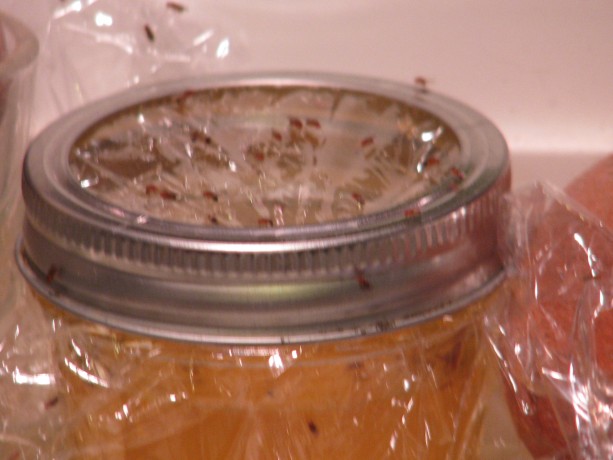
A kind of blurry photo of lots and lots of fruit flies queuing up to get inside. - Animals, Bees, Birding, Chickens, Cob, Compost, Composting toilet, Fungus and Mushrooms, Gardening adventures, Health, Heirloom Plants, Hiking, Humor, Living structures, Natives, Natural cleaners, Other Insects, Permaculture and Edible Forest Gardening Adventures, Pets, Photos, Ponds, Predators, Quail, Rain Catching, Reptiles and Amphibians, Seeds, Soil, Water Saving, Worms
Finch Frolic Facebook!
Thanks to my daughter Miranda, our permaculture food forest habitat Finch Frolic Garden has a Facebook page. Miranda steadily feeds information onto the site, mostly about the creatures she’s discovering that have recently been attracted to our property. Lizards, chickens, web spinners and much more. If you are a Facebook aficionado, consider giving us a visit and ‘liking’ our page. Thanks!
- Animals, Chickens, Cob, Compost, Composting toilet, Fruit, Gardening adventures, Giving, Grains, Health, Herbs, Houses, Hugelkultur, Humor, Living structures, Natives, Natural cleaners, Permaculture and Edible Forest Gardening Adventures, Ponds, Rain Catching, Recipes, Seeds, Soil, Vegan, Vegetables, Vegetarian, Worms
San Diego Permaculture Convergence, Nov. 9 – 10, 2013
There is a fantastic, information-packed permaculture convergence coming up at the beautiful Sky Mountain Institute in Escondido.
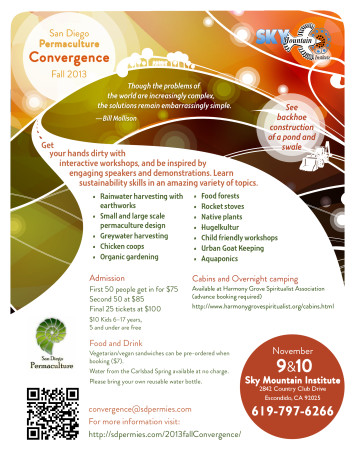 It will be two days packed with great information for a very reasonable price; in fact, scholarships are available. Check out the website at convergence@sdpermies.com. On that Sunday I’ll be teaching a workshop about why its so important to plant native plants, how to plant them in guilds using fishscale swales and mini-hugelkulturs. Come to the convergence and be inspired!
It will be two days packed with great information for a very reasonable price; in fact, scholarships are available. Check out the website at convergence@sdpermies.com. On that Sunday I’ll be teaching a workshop about why its so important to plant native plants, how to plant them in guilds using fishscale swales and mini-hugelkulturs. Come to the convergence and be inspired! - Animals, Bees, Chickens, Health, Natural cleaners, Other Insects, Permaculture and Edible Forest Gardening Adventures, Pets, Quail, Worms
DE for Birds, and More About Chickens
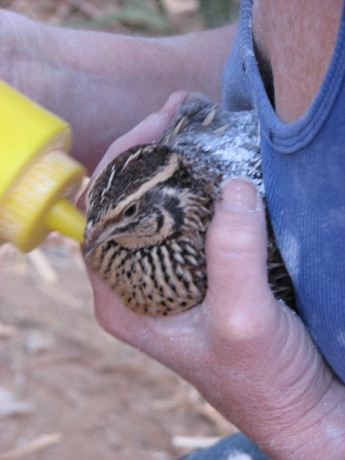
A little mustard with your quail? Cleopatra being treated. I’ve written about using Food Grade Diatomaceous Earth around plants to keep down ants and other sectioned insects. It is also used around the feet of my bee hives; as long as it isn’t where bees and other beneficials go it won’t hurt them because it has to be on the bug to work. I’ve also used FGDE around my cat’s bedding to kill hatching flea eggs, and have rubbed it into their fur. It is scentless, edible (will help kill interior parasites when eaten), tasteless, and the food grade is so fine that it won’t hurt your lungs if you breathe it in, although if you have lung conditions you should wear a mask. More about FGDE in a minute.
Some of our laying hens have difficulty laying eggs recently. Chickpea we found panting on the ground in a wet spot, with ants on her. She had a soft-shelled egg break inside of her.

Madge in the house cage, recooperating. Madge, our partially blind RIR passed a soft shelled egg, then was ill for a day when she passed a broken shell. Warm Epsom salts baths and time spent in the house cage with a heating pad helped both of them. Because of the threat of infection I used some of the Cephalexin left over from our dog (divided into small doses) on both of them and they recovered. My daughter finally deduced that in the mornings when the pullets and hens were released the big girls ran over to eat the chick mash. It probably tastes better than the lay pellets, and more importantly in their little brains it kept the pullets from eating it. Even with the supplemental oyster shell the big girls were probably not getting the calcium and other nutrition their bodies needed to make good eggs. It was time to switch the small girls to lay mash anyway, so I did and yesterday we had all four of our laying hens lay eggs… first time in a long time!
While we were bathing Madge in the sink for her illness, my daughter noticed mites on her. Now a few mites are usual on everyone and everything. When you can see several on the skin when you blow on the feathers, then you have a problem. She wasn’t having a problem, but at that time we still didn’t know what was wrong with her. After she was better we instituted FGDE Day in the Fowl Fortress.
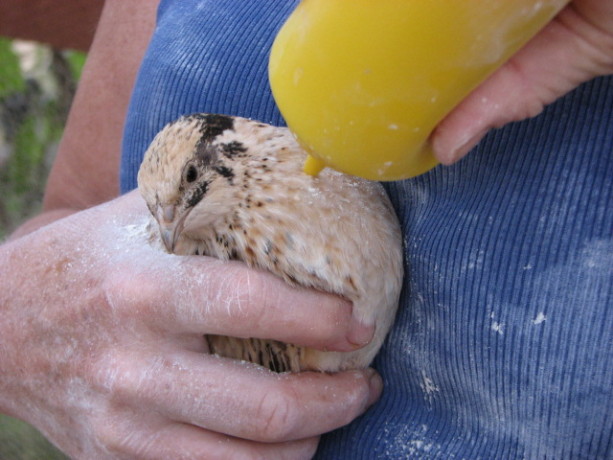
Miss Lemon, one of three coturnix hens, is treated with FGDE. You can buy pricey powder dispensers, which usually clog. I bought a set of mustard and ketchup dispensers for less than two dollars and they work just fine. We caught all the hens and our three quail and puffed FGDE into their feathers and, of course, all over ourselves.
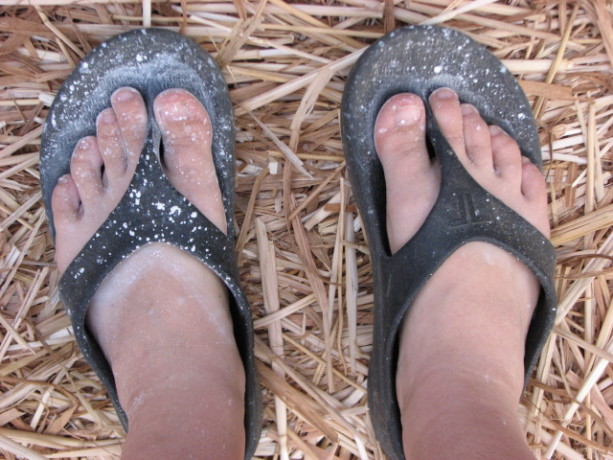
We treat ourselves, too. I puffed it into the nesting boxes, and into the ‘attic’ of the pullet house where they roost, and into the straw in the coops. Since we don’t have a problem we don’t need to treat often, just every few months or so. Any that they eat helps with any internal parasites as well. We also had some wood ash left over from making pizzas in Harry Mud the cob oven and sprinkled them where the birds take dust baths. That fine ash helps to keep their feathers clean and keep away mites too.
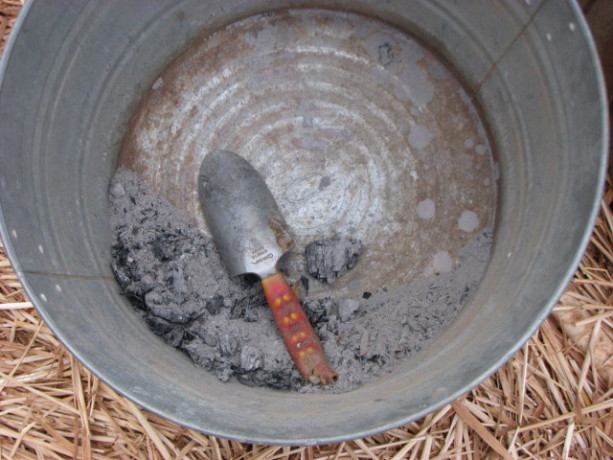
Wood ashes are good for dust baths. Very little went a long way, so even after treating all the hens and the Fowl Fortress, the cat bedding repeatedly, several cats, the feet of the bee hives, a variety of plants, and the feet of the food tables I’d set up for a garden party to protect from ants, along my window sills and around the privy where ants were getting in, I’m still working on the first bag that I bought on Amazon.com.
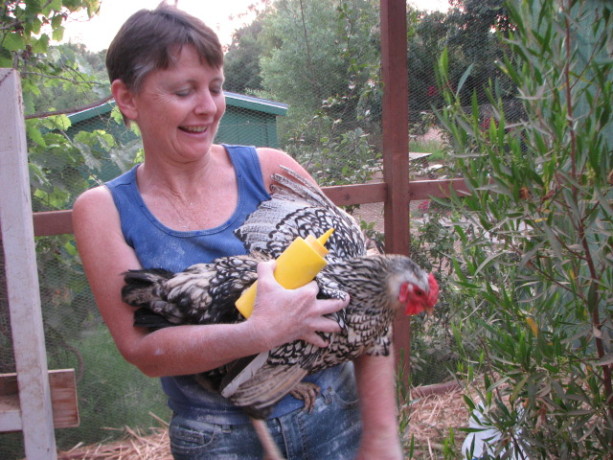
Amelia objecting to her dusting. When you compare with buying expensive different poisons for all of these problems, the health hazards and impact on non-target species including ourselves, and the negative impact on the Earth, one bag of FGDE is such a deal that you really can’t not try it.
-
Yes There Is A Bleach Alternative That Works!
Bleach does wonders for whites, kills germs and purifies water. It is also a toxic chemical, it kills the microbes in your septic tank, it corrodes what it touches and can do your lungs, skin and eyes major harm, especially when combined with other chemicals. Many over-the-counter natural cleansers seem weak and probably don’t do a good job disinfecting, besides being very costly. Here is a recipe for success: a safer bleach alternative that really works. Vinegar is of course a fantastic cleaner, but if the pervasive smell of Easter eggs is too much for you, then how about the smell of citrus? I have plenty of lime trees so I have an ongoing supply of lime juice, but an inexpensive bottle of lemon juice works as well. I’m going to direct you to a blog link on Grit magazine’s ezine, because I certainly can’t do better than Lucy Razor’s very through and well-researched article. So here is the recipe for natural bleach alternative. Now go make up a batch!
